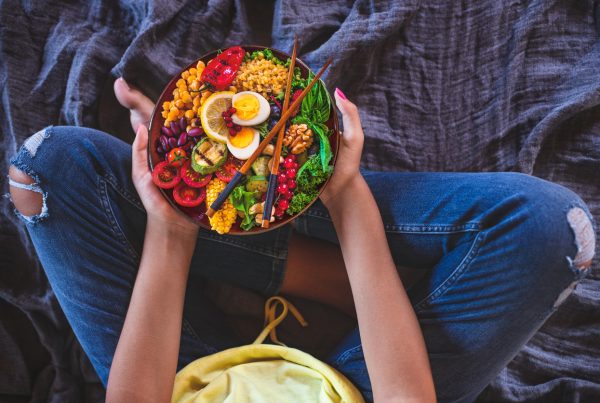Dr Linia Patel breaks down our fears around fat and explains why we need certain fats to function.
Many people hear the words ‘high fat’ and feel like they should run for the hills! However, classifying all fats as fearful entities is not right. Yes, there are twice as many calories in fat (9kcal/g) than in carbohydrate or protein (4kcal/g) when measured gram for gram; however, a zero-fat diet is bad for you! In reality, fat is a normal and healthy part of the diet. Some fats in your diet are essential.
Your body needs fat! Why?1
- Fat gives you energy.
- Fat helps your body to absorb key vitamins like A, D, E and K1.
- Fat keeps you warm.
Fat in the diet only becomes problematic when consumed in excess or when we manipulate its natural structure.
Fat chemistry1
All fats have a similar chemical structure: a chain of carbon atoms bonded to hydrogen atoms. What makes one fat different from another is the length and shape of the carbon chain and the number of hydrogen atoms connected to the carbon atoms. Depending on their chemical structure, fats are classified as saturated or unsaturated fat (monounsaturated or polyunsaturated).
The good, the bad, the ugly in fat terms
The good – unsaturated fats1,2,3
Unsaturated fats are usually liquid at room temperature and are considered beneficial fats because they can improve blood cholesterol levels, support a healthy heart, ease inflammation and play a number of other beneficial roles. There are two types of ‘good’ unsaturated fats: monounsaturated fats and polyunsaturated fats.
Monounsaturated fats
Monounsaturated fats are found in high concentrations in:
- extra virgin olive oil
- avocado
- most tree nuts (brazil, almond, hazelnut and pecans)
- canola oil.
Tip: Although these oils are good for you, you still need to watch the portions! How much of each you can have depends on your activity levels. Speak to a dietitian or registered nutritionist to determine how much you need.
Polyunsaturated fats – essential fats4,5,6,7
Essential fatty acids are like the vitamins of the fat world. We need to get them in our diets. There are two families of essential fatty acids: omega-3 (n−3) and omega-6 (n−6) fatty acids.
Long-chain omega-3 fatty acids are EPA (eicosapentaenoic acid) and DHA (docosahexaenoic acid). These are primarily found in oily fish. Algae often provides only DHA. Short-chain omega-3 fatty acids are ALA (alpha-linolenic acid). These are found in plants, such as flaxseed, chia seeds, walnuts and pumpkin seeds. Though beneficial, ALA omega-3 fatty acids require extensive metabolism in the body to generate EPA and DHA which the body uses (the active components that can do the health-promoting work). In addition, the conversion of ALA to DHA and EPA depends on factors like age, sex, genetics, micronutrient intake and deficiencies, as well as alcohol intake. Food sources of omega-6 fatty acids include vegetable oils, such as soybean, safflower and corn oil, nuts and seeds. Think too of animal sources that are fed with soy or corn.
Sources of essential fats
| Omega-3 fatty acids | Omega-6 fatty acids |
| Oily fish such as mackerel, salmon, pilchards, sardines, herring, haddock and anchovies or fish oil supplements
|
Sunflower seeds and oils |
| Seaweed/algae | Soybean or corn oil |
| Walnuts | Vegetable oil blends |
| Flaxseed or chia seeds | Peanuts |
| Pumpkin seeds | Animal products from animals fed soy or corn |
As a nation, we are consuming more and more omega-6 oils and fewer omega-3 oils. This overconsumption is problematic and has led to the increase in inflammatory conditions such as Alzheimer’s and cardiovascular diseases, diabetes and cancer.
The not-so-good fat: Saturated fat1,8
Saturated fats have a straight chain of carbon atoms. This flat structure allows them to pack easily and so they tend to be solid at room temperature. Saturated fats have no nutritional value beyond the calories they contain. They taste really good and they also improve ‘mouth feel’, which the food industry monopolises on. Saturated fats make processed products more appealing to the palate (think melt-in-the-mouth chocolate). As they are tasty, we tend to overeat these fats and this is why they end up being not so good for us. A high intake of saturated fats has been associated with poor cholesterol profiles and an increased risk of cardiovascular disease and diabetes.
Saturated fats can be found in:
- fatty meat or chicken skin
- highly processed foods (hot dogs, deli meats, donuts, cakes, chocolate, biscuits)
- high-fat dairy products
- coconut oil and palm oil.
The ugly fat: Trans fats1,8
Trans fats are man-made fats. They are industrially produced when vegetable oils are partially hydrogenated. They are used as they add flavour, texture and increase the shelf life of products. The problem is that our body cannot break down trans fats, so they accumulate in the body and have been found to be strongly correlated to an increased risk of chronic diseases like heart disease, diabetes and cancer. Trans fats are most often found in commercially baked goods, fried foods and processed foods like packaged salty snacks. Look for hydrogenated fats in the label.
What fats to cook with9,10,11
So now you know that trans fats are produced by the food industry and not good for you. Perhaps what you may not know is that trans fats can also be made in your home! When fats and oils are heated at or close to their smoke point, their molecular structure changes through a process of oxidation, producing chemicals called aldehydes. The most important factor in determining oil’s resistance to oxidation is the relative degree of saturation of the fatty acids in it. Saturated fats have only single bonds in the fatty acid molecules, monounsaturated fats have one double bond and polyunsaturated fats have two or more. It is these double bonds that are chemically reactive and sensitive to heat.
Saturated fats (such as coconut oil, butter or goose fat) are the most resistant to heating. Monounsaturated fats like olive oil can only be heated to 180⁰C and can therefore be used on salads and to sauté food. Although polyunsaturated fats like sunflower oil and peanut oil have a higher smoke point, their intake should be limited as they are also high in omega-6 oils. If you need to cook something at a high temperature (e.g., stir fries or roasted potatoes) it is best to use saturated fats like coconut oil or even goose fat as these types of fat are more stable at higher temperatures. In my clinical practice, I recommend choosing an oil or fat that is high in monounsaturated or saturated lipid (preferably more than 60% for one or the other and more than 80% for the two combined) and low in polyunsaturated (less than 20%). Remember, whatever oil you choose – it’s all about portion control!
Know your oils12,13
| Type of oil/fat | Polyunsaturated (%) | Monounsaturated (%) | Saturated (%) |
| Coconut oil | 2 | 6 | 86 |
| Butter | 3 | 21 | 51 |
| Lard | 11 | 45 | 39 |
| Goose fat | 11 | 56 | 27 |
| Olive oil | 10 | 76 | 14 |
| Corn oil | 54 | 27 | 12 |
| Sunflower oil | 65 | 20 | 10 |
| Sesame oil | 41 | 40 | 14 |
| Rapeseed Oil | 28 | 63 | 7 |
Key messages
- Do not ignore fat and calorie intake: a high-fat diet will make you fat! You need to keep your fat portion in check even if they are ‘good’ fats.
- Use a tablespoon of virgin olive oil a day as your dressing for a salad or use it when you cook (i.e., for low-heat sautéing).
- Eat three or four portions of oily fish per week or consider sourcing a good fish oil supplement.
- Avoid intake of vegetable fats that have been cooked at a high temperature.
- Get your essential fatty acids from a handful of raw nuts and seeds a day.
- Have a thumb of butter or cheese a day.
- Keep your intake of trans fats to a minimum.
- Don’t make a pact with any certain oil. As with many dietary recommendations, variety is the key. Your fat and oil staples include, for example, extra virgin olive oil, unrefined avocado oil, unrefined coconut oil and butter.
- Store well. Keep your oils out of the light in a cupboard and definitely don’t re-use them.
Have you checked out Linia’s best-selling online educations?
- Nutrition for Menopause
- Gut Health – the power of the microbiome
- Low Carb: the evidence & application
- Sports Nutrition Basics
- Plant-Based Eating: The Essentials
- Food as Medicine? Food and inflammation
Which one will you choose?
About the author

Dr Linia Patel has a BSc degree in biochemistry and physiology and has recently achieved a PhD in public health. Linia is a leading dietitian and sports nutritionist. Her passion is translating nutritional science into easy-to-digest and practical advice.
References
- British Dietetic Association. Food Facts. Fat. https://www.bda.uk.com/food-health/food-facts/all-food-fact-sheets.html?topic=031B0B7E-184C-42D5-8FDAB5B27B5D23A6&sortBy=date, accessed on 18 March 2021.
- Kontogianni MD, Vidra N, Farmaki AE et al (2008), Adherence rates to the Mediterranean diet are low in a representative sample of Greek children and adolescents, J Nutr., 138(10): 1,951-6.
- Kastorini CM, Milionis HJ, Esposito K et al (2011), The effect of mediterranean diet on metabolic syndrome and its components: A meta-analysis of 50 studies and 534,906 individuals, Journal of the American College of Cardiology, 57: 1,299-1,313.
- Innes J (2018), Omega-6 fatty acids and inflammation, Prostaglandin Leukot Essent Fatty Acids, 132: 41-48.
- Calder et al (2017), Omega-3 fatty acids and inflammatory processes: from molecules to man, Biochem Soc Trans., 15, 45(5): 1,105-15.
- Calder et al (2015), Marine omega-3 fatty acids and inflammatory processes: Effects, mechanisms and clinical relevance, Biochem Biophys Acta., 1851(4): 469-84.
- Gao H et al (2017), Fish oil supplementation and insulin sensitivity: A systematic review and meta-analysis, Lipids Health Dis., 3:16(1): 132.
- Keys A (1980), Seven countries: a multivariate analysis of death and coronary heart disease, London: Harvard University Press.
- Thomas B & Bishop J (eds) and The British Dietetic Association (2007), Manual of Dietetic Practice, Fourth Edition, Oxford: Blackwell Publishing.
- Felton CV, Crook D, Davies MJ, Oliver MF (1994), Dietary polyunsaturated fatty acids and composition of human aortic plaques, Lancet, 344: 1,195-6.
- De Souza RJ et al (2015), Intake of saturated and trans fats unsaturated fatty acids and risk of all-cause mortality, cardiovascular disease, and type 2 diabetes: systematic review and meta-analysis of observational studies, BMJ: 351: h3978.
- Smoking points of oils on Wikipedia, https://en.wikipedia.org/wiki/Template:Smoke_point_of_cooking_oils, , accessed on 18 March 2021.
- Refining of Oils, http://www.fao.org/docrep/v4700e/V4700E0a.htm, accessed on 18 March 2021.








